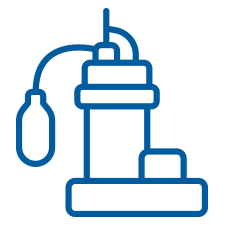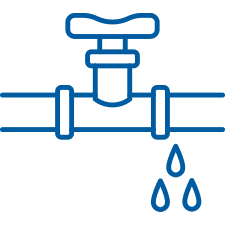
When your concrete patios, walkways, or driveways settle, crack, or become uneven, you face two primary repair options: full concrete replacement or modern polyurethane concrete lifting (PolyLevel®). Below, we dive into the factors that matter—climate impacts, process overviews, cost and timeline comparisons, cleanup differences, technical details, FAQs, and more—to help you decide which solution is best for your home.
Concrete Settlement Causes: Freeze-Thaw, Drought & Heavy Rains
Concrete in the Chicagoland area faces a unique combination of stresses that accelerate settling and cracking:
- Freeze-Thaw Cycles: Water seeps into cracks, freezes, and expands, opening gaps each winter.
- Summer Droughts: Extended dry spells cause soil beneath slabs to shrink and pull away.
- Heavy Spring & Summer Rains: Rapid saturation can wash out supporting soils, creating voids underneath the concrete.
- Soil Swell-Shrink Behavior: Alternating wet/dry conditions cause expansive clay soils to swell when wet and shrink when dry.
Local Stat: In our Chicagoland and surrounding Midwest region, nearly 30% of residential slabs show measurable settling within five years.

Full Concrete Replacement: Process, Costs & Timeline
Many homeowners think that replacing the concrete is the best solution for settlement and cracks, but what are the hidden costs?
Concrete Replacement Steps:
- Demolition & Removal: Jackhammer old slab into debris; haul it away.
- Subgrade Preparation: Re-grade and compact soil; add gravel or sand.
- Formwork & Pour: Build forms, pour fresh concrete, finish surface to spec.
- Curing Time: Foot traffic in 24-72 hours; vehicles in 5-7 days.
Hidden Cost Drivers:
- Labor & Time: Multiple crew members over several days.
- Disposal Fees: Hauling broken concrete can cost $200-$500.
- Permits: Municipal requirements add $50-$150.
- Landscaping Repair: Adjacent lawns and plant beds often need restoration.
Polyurethane Concrete Lifting (PolyLevel®): Process & Benefits
PolyLevel® can bring settled concrete slabs back to level permanently with high-density foam that cures completely in as little as 2 hours.
Concrete Lifting Process:
- Drill Ports: 3/4″ holes at low-spot locations.
- Inject Foam: A two-component liquid expands 25x to fill voids and lift concrete.
- Seal & Clean: Patch holes flush with grout; sweep surface clean.
Technical Highlights:
- Foam Composition: Closed-cell urethane that’s waterproof and erosion-resistant.
- Load Capacity: Supports over 8,000 psi—on par with new-pour concrete.
- Cure Time: Surface ready for foot traffic in 15-20 minutes; vehicles in 1-2 hours.
Important Fact: PolyLevel®, also known as polyurethane concrete lifting, is a permanent fix. The high-strength 2-part foam is waterproof and erosion resistant, which means that it will stay strong and support your concrete through winter weather, heavy rain, and more.
Cost Comparison: Replacement vs. Polyurethane Lifting
On average, PolyLevel® delivers 20-40% savings over replacement.
| Method | Cost per sq ft | Total for 200 sq ft |
|---|---|---|
| Full Replacement | $8–$15* | $1,600–$3,000 |
| PolyLevel® Concrete Raising | $5–$7* | $1,000–$1,400 |
*Pricing estimates for PolyLevel and traditional concrete replacement are based on an average project. Your project may vary. Free consultations and estimates are available from Perma-Seal before any work is done.
Timeline Comparison: Replacement vs. One-Day Concrete Raising
PolyLevel® restores your surface in a single day; replacement takes up to a week.
| Method | Cost per sq ft | Total for 200 sq ft | Total Duration | Foot Traffic | Vehicles |
|---|---|---|---|---|---|
| Full Replacement | $8–$15 | $1,600–$3,000 | 3–7 days | 24–72 hours | 5–7 days |
| PolyLevel® Concrete Raising | $5–$7 | $1,000–$1,400 | 1 day | 15–20 minutes | 1–2 hours |
Cleanup Impact: Replacement Debris vs. Polyurethane Raising
Replacement Mess:
- Piles of broken concrete and dust
- Heavy equipment tracks on grass and driveways
- Potential damage to irrigation lines or plant beds
Polyurethane Raising Cleanup:
- Only drill-size holes are patched seamlessly
- Virtually zero dust or debris
- Landscape and hardscape remain intact
Before and After Concrete Leveling


Durability & Warranty: Why Choose Polyurethane Concrete Lifting
- Resists Moisture & Erosion: Closed-cell structure won’t wash out.
- Maintains Lift: Clients report zero settling even after multiple Chicago winters.
- Supports Heavy Loads: More than 8,000 psi load capacity.
- Backed by Warranty: Standard 5-year transferable warranty; optional upgrades to 10 years.
Resale Benefit: A transferable warranty can boost buyer confidence and home value.
Site Preparation & Service Expectations With Concrete Lifting
To ensure a smooth service day:
- Clear the Area: Move furniture, planters, and vehicles off the slab.
- Mark Utilities: Identify underground irrigation or lighting.
- Plan for Noise: Foam injection is quiet; drilling makes light noise for 10-15 minutes.
- Post-Service Care: Avoid heavy loads for 2 hours; no special maintenance afterward.
FAQs: Concrete Raising vs. Replacement Questions Answered
Will the foam wash away in heavy rain?
No—closed-cell polyurethane is waterproof and resists soil erosion.
Can I change the finish or color?
Does concrete lifting require a permit?
How long do I need to stay off it after the concrete lifting process is complete?
Is polyurethane concrete lifting eco-friendly?
Choosing the Right Repair: Replacement vs. Polyurethane Raising
Choose Replacement if: Concrete is crumbling or structurally failing; you desire a fresh finish, color, or stamp.
Choose PolyLevel® Concrete Raising if: Slab is sound but uneven or sunken; you value speed, cost savings, and minimal yard impact.
Schedule a Free Estimate for Concrete Raising In Chicago
Don’t let settled concrete slow you down. Concrete raising is a quick and long-lasting way to fix your uneven concrete.
Schedule your free estimate with Perma-Seal today. Call 800-421-7325 or click the button below to fill out our online contact form.







